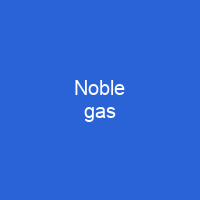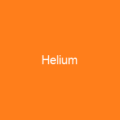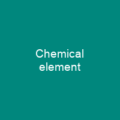Noble gases are odorless, colorless, monatomic gases with very low chemical reactivity. The six naturally occurring noble gases are helium, neon, argon, krypton, xenon, and the radioactive radon. Oganesson is variously predicted to be a noble gas as well or to break the trend due to relativistic effects; its chemistry has not yet been investigated.
About Noble gas in brief
 Noble gases are odorless, colorless, monatomic gases with very low chemical reactivity. The six naturally occurring noble gases are helium, neon, argon, krypton, xenon, and the radioactive radon. Oganesson is variously predicted to be a noble gas as well or to break the trend due to relativistic effects; its chemistry has not yet been investigated. Noble gases have several important applications in industries such as lighting, welding, and space exploration. A helium-oxygen breathing gas is often used by deep-sea divers at depths of seawater over 55 m. Helium is sourced from natural gas fields that have high concentrations of helium in the natural gas, using cryogenic gas separation techniques. radon is usually isolated from the radioactive decay of dissolved radium, thorium, or uranium compounds. In 1902, having accepted the evidence for the elements helium and argon, Dmitri Mendeleev included these noble gases as group 0 in his arrangement of the elements, which would later become the periodic table. After the risks caused by the flammability of hydrogen became apparent in the Hindenburg disaster, it was replaced with helium in blimps and balloons. Noble gas is translated from the German noun Edelgas, first used in 1898 by Hugo Erdmann to indicate their extremely low level of reactivity, the name makes an analogy to the term \”noble metals\”, which also have low reactivity and are also known as inert gases. The melting and boiling points for a given noble gas are close together, differing by less than 10 °C ; that is, they are liquids over only a small temperature range.
Noble gases are odorless, colorless, monatomic gases with very low chemical reactivity. The six naturally occurring noble gases are helium, neon, argon, krypton, xenon, and the radioactive radon. Oganesson is variously predicted to be a noble gas as well or to break the trend due to relativistic effects; its chemistry has not yet been investigated. Noble gases have several important applications in industries such as lighting, welding, and space exploration. A helium-oxygen breathing gas is often used by deep-sea divers at depths of seawater over 55 m. Helium is sourced from natural gas fields that have high concentrations of helium in the natural gas, using cryogenic gas separation techniques. radon is usually isolated from the radioactive decay of dissolved radium, thorium, or uranium compounds. In 1902, having accepted the evidence for the elements helium and argon, Dmitri Mendeleev included these noble gases as group 0 in his arrangement of the elements, which would later become the periodic table. After the risks caused by the flammability of hydrogen became apparent in the Hindenburg disaster, it was replaced with helium in blimps and balloons. Noble gas is translated from the German noun Edelgas, first used in 1898 by Hugo Erdmann to indicate their extremely low level of reactivity, the name makes an analogy to the term \”noble metals\”, which also have low reactivity and are also known as inert gases. The melting and boiling points for a given noble gas are close together, differing by less than 10 °C ; that is, they are liquids over only a small temperature range.
The noble gases have also been called rare gases, but this is also inaccurate because argon forms a fairly considerable part of the Earth’s atmosphere due to decay of radioactive potassium-40. In 1898, E. J. Rayleigh and William Ramsay received the Nobel Prizes in Physics, respectively, for their discovery of the noble gases in the words of Jorn Dorn and E. E. Ramsay. Radon was first identified in 1898, but was not considered a noble gases until 1904, when its characteristics were found to be similar to those of other noble gases. For the first six periods of the periodic table, the Noble gases are exactly the members of group 18. The properties of noble gases can be well explained by modern theories of atomic structure: their outer shell of valence electrons is considered to be \”full\”, giving them little tendency to participate in chemical reactions, and it has been possible to prepare only a few hundred noble gas compounds. For example, argon is used in incandescent lamps to prevent the hot tungsten filament from oxidizing; also, helium is used to prevent oxygen, nitrogen and carbon dioxide toxicity in deep- sea divers to prevent toxicity. In 1904, Ramsay also managed to isolate helium for the first time while heating cleveite, a mineral.
You want to know more about Noble gas?
This page is based on the article Noble gas published in Wikipedia (as of Dec. 03, 2020) and was automatically summarized using artificial intelligence.







